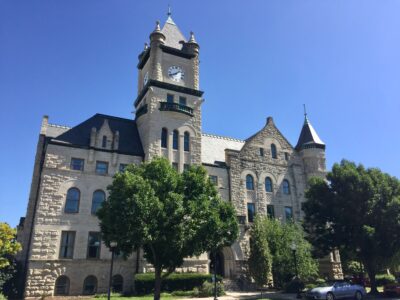Final comment period now open for City of Lawrence, county blueprint guiding long-range plan for transportation system

photo by: City of Lawrence
A Lawrence Transit electric bus is pictured in this contributed photo.
The latest version of the long-range plan guiding Douglas County’s transportation system should be finalized in a matter of months, and it would call for reducing greenhouse gas emissions, improving the city’s amenities for cyclists and more.
The draft plan — dubbed “Transportation 2050” — was released on Monday for a 30-day public comment period that ends Wednesday, Feb. 22. The Lawrence-Douglas County Metropolitan Planning Organization revises its long-range plan for the county’s transportation system once every five years. This plan, if adopted by the Metropolitan Planning Organization’s policy board as planned in March, will replace the previous “Transportation 2040” iteration that was adopted after a year-and-a-half-long planning process in 2018.
Transportation planning manager Jessica Mortinger told the Journal-World Tuesday that planning staff has been engaging with community members about the plan for much of the past year, including both online surveys and in-person events at places like the Lawrence Public Library and the downtown farmers market. That resulted in almost 750 survey responses from members of the public that have helped guide planners as they have crafted the plan.
“This is really the foundation of how we do our work, because we can’t write this plan in a vacuum,” Mortinger said. “It involves feedback and input already from the community, and we figure out what we heard in terms of the diverse perspectives of the community about transportation.”
The draft plan is more than 300 pages long, and it groups its objectives and suggestions into five broad areas — transportation options, shared prosperity, safety and security, sustainability and operations and maintenance.
Under sustainability, for instance, some of the goals include increasing the percentage of trips made using active, shared and low-carbon forms of transportation, as well as minimizing negative environmental impacts by reducing greenhouse gas emissions and avoiding or mitigating the impact of transportation projects on the water and the air. The suggestions for achieving these goals include transitioning publicly funded vehicle fleets, like Lawrence Transit’s bus service, to zero-emission vehicles.
For the safety and security area, one big goal is to reduce the number of traffic fatalities, and the transportation options section sets a goal of increasing the percentage of public streets that are bike-friendly.
The plan also details a number of transportation-related projects, some of which have already begun and others which are still in the pipeline.
One project that might sound familiar is Lawrence Transit’s new “microtransit” pilot program, which is supposed to roll out this year and would function similarly to ride-share apps like Uber or Lyft but use transit vehicles and drivers. The plan also mentions Lawrence Transit’s project to construct a new bus station at the southeast corner of Bob Billings Parkway and Crestline Drive.
A few other projects mentioned in the plan include:
• A multimodal “wayfinding plan,” which would involve a network of signage to direct people to specific destinations. The first step would be a bicycle wayfinding project that is set to be implemented this year.
• Developing a plan to prevent serious and fatal crashes involving bicyclists and pedestrians by making them more visible to drivers.
• Implementing “nature-based solutions” — sustainable planning, design, environmental management and engineering practices that weave natural features or processes into infrastructure projects. That could include things like restoring and protecting wetlands or using street trees to reduce air pollution.
There’s also some more technical data in the plan, such as a model that projects travel demand based on certain conditions and elements like projected population and employment growth.
“The goal would be, and why we do this scenario planning, is to project long-term what … policy decisions need to be made in land use and how those policy decisions as we look at them would impact transportation needs,” Mortinger said.
The Metropolitan Planning Organization plans to adopt the Transportation 2050 plan in March, and Mortinger said there are a number of ways the public can offer feedback about the draft before then. One option is a survey the Metropolitan Planning Organization has already been using to get feedback throughout the plan-writing process, all of which can be viewed by any member of the public after they’re submitted. Comments can also be submitted via email to mpo@lawrenceks.org or mailed to planners at the City Hall Riverfront Plaza building, 1 Riverfront Plaza. Mortinger said those comments will also be added to the catalog of survey responses so they’re publicly viewable.
The full draft plan can be viewed on the City of Lawrence’s website.







